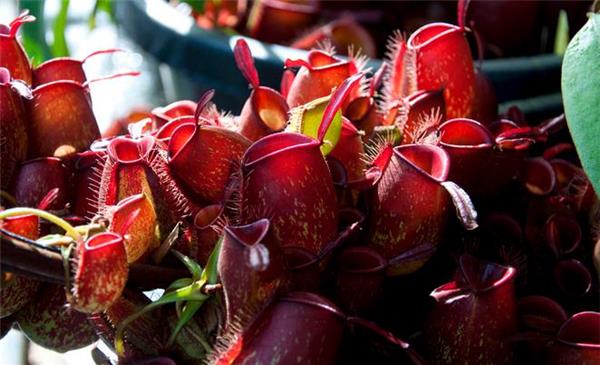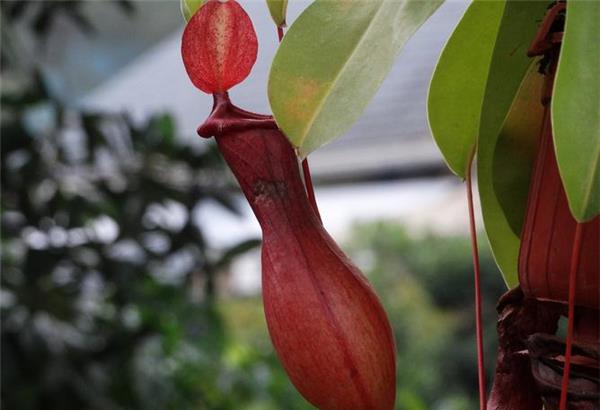How much do you know about apple pitchers?
Pitcher plant is a tropical insectivorous plant, named because it is shaped like a pig cage. So, how much do you know about the breeding method of apple pitcher plant? Maybe some friends don't know much about this. Let's give you a brief introduction today. Let's take a look at it together.

Introduction of pitcher plant
Pitcher plant is the general name of all species of pitcher plant. It belongs to tropical insectivorous plants, and its origin is mainly in the tropics of the old world. It has a unique nutrient-absorbing organ-the insect cage, which is cylindrical in shape, the lower half is slightly inflated, and the mouth of the cage has a lid, so it is named because it is shaped like a pig cage.
The leaves of pitcher plants are complex in structure, with petioles, leaf bodies and tendrils. The tail of the tendril is enlarged and rolled back to form a bottle, which can prey on insects. The pitcher plant has racemes with small green or purple flowers and the vase at the top of the leaf is a tool for preying on insects. The cover of the bottle can separate the fragrance and attract insects. The mouth of the bottle is smooth, and the insects will be slipped into the bottle, drown by the liquid secreted from the bottom of the bottle, and decompose the nutrients and gradually digest and absorb them.
Morphological characteristics of pitcher plant
The pitcher plant is a perennial vine with woody or semi-woody stems, more than 3 meters tall, climbing on trees or along the ground. The leaves are generally long oval, with cage vines at the end for easy climbing. A bottle-shaped or funnel-shaped trap with a cage cover will be formed at the end of the vine. The pitcher plant does not blossom until it has grown for many years. The flowers are generally racemes, a few panicles, dioecious, small and plain, light and fragrant during the day, and strong and smelly at night. Its ornamental ability can not be compared with that of insect traps. The fruit is a capsule, dehiscing and spreading seeds at maturity.

The culture method of apple pitcher plant
Soil: loose, fertile and breathable rotten leaf soil or peat soil is better. A mixed substrate of peat soil, water moss, charcoal and fir sawdust is often used in pots.
Watering: pitcher plants are sensitive to water. Pitcher plants can only grow and develop normally under high humidity conditions. During the growing period, pitcher plants need to spray water frequently, 4 or 5 times a day. If the temperature changes greatly and is too dry, it will affect the formation of leaf cages.
Sunshine: the pitcher plant is an epiphytic plant, which often grows under the forest or on the north side of the rock. The natural condition is semi-overcast. Under the strong light in summer, the leaves must be shaded, otherwise the leaves are easy to burn and directly affect the development of the leaf cage. However, under dark conditions for a long time, the leaf cage forms slowly and small, and the color of the cage surface is dim.
Temperature: the suitable temperature for the growth of pitcher plant is 2530 ℃, 2130 ℃ from March to September, and 1824 ℃ from September to March of the following year. The winter temperature was not lower than 16 ℃, the plants below 15 ℃ stopped growing, and the leaf edges suffered frost damage when the temperature was below 10 ℃.

Fertilization: pitcher plants do not need special fertilization, because pitcher plants can usually feed on insects to transform nutrients, if pitcher plants have insects to eat, there is no need to apply fertilizer.
Insect pests: pitcher plants are often harmed by leaf spot and shell insects. Leaf spot disease was sprayed with 1000 times of 50% Dysen zinc wettable powder. The shell worm was sprayed with 2000 times of 40% dimethoate EC.
Pruning: the cage of the pitcher plant is a kind of abnormal leaf, so it will age and die like the leaves of other plants. Generally speaking, each cage can survive for several months under suitable conditions. When it has withered, it can be cut off to make the whole plant look more beautiful, but this is purely for the sake of beauty and has nothing to do with the health of the plant.

This is the end of the introduction of the breeding methods of apple pitcher plants. I believe that after reading it, we have a certain understanding of the breeding methods of apple pitcher plants. I hope the relevant knowledge introduced today will be helpful to all of you.
Related
- Wuhan Hospital Iron Tree Blooming Result Was Instantly Frightened by the Gardener Master
- Which variety of camellia is the most fragrant and best? Which one do you like best?
- What is the small blue coat, the breeding methods and matters needing attention of the succulent plant
- Dormancy time and maintenance management of succulent plants during dormancy
- Minas succulent how to raise, Minas succulent plant pictures
- What are the varieties of winter succulent plants
- How to raise succulent plants in twelve rolls? let's take a look at some experience of breeding twelve rolls.
- Attention should be paid to water control for succulent plants during dormant period (winter and summer)
- Watering experience of twelve rolls of succulent plants
- Techniques for fertilizing succulent plants. An article will let you know how to fertilize succulent plants.



